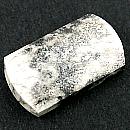|
|
|
|
Click on a letter above to view the list of gems. |
|
|
|
|
|
Silver
(Native) |
|
| Chemistry: Ag [Elemental Silver] | |
| Discovered
in Prehistory;
IMA
status: Valid (pre-IMA; Grandfathered). | ||
|
| ||
|
Classification |
|
|
| |
|
Elements | |
|
1/A.01-10 | |
|
|
1 : ELEMENTS (Metals and intermetallic alloys; metalloids and
nonmetals; carbides, silicides, nitrides, phosphides) |
|
Related to: |
Copper Group. Gold - Silver Series. Palladium - Silver Series. |
|
|
|
|
Crystal Data |
|
|
|
|
|
Crystals commonly cubic, octahedral, or dodecahedral, to 2 cm; in parallel groups; more commonly as elongated, wiry, arborescent, or reticulated forms. Massive, in scales, sheets, and as coatings. |
|
|
On [111] as simple pairs and repeated in aggregates radiating along [111] axes. |
|
|
|
|
|
Physical Properties |
|
|
|
|
|
None |
|
|
Hackly, Jagged |
|
|
Highly Malleable and Ductile |
|
|
2.5 - 3.0 |
|
|
10.1 - 11.1 (g/cm3) (10.5 when pure) |
|
|
None |
|
|
Not Radioactive |
|
|
Other: |
Highly Conductive; Paramagnetic (weakly attracted to very strong magnetic fields) |
|
|
|
|
Optical Properties |
|
|
|
|
|
Silver White, Gray White, Gray; tarnishes Gray to Black; in polished section, brilliant Silver-White |
|
|
Opaque |
|
|
Metallic |
|
|
R: (400) 83.4, (420) 84.5, (440) 86.0, (460) 87.7, (480) 89.1, (500) 90.5, (520) 91.8, (540) 93.0, (560) 93.5, (580) 93.7, (600) 94.0, (620) 94.4, (640) 94.7, (660) 95.2, (680) 95.6, (700) 96.0 |
|
|
0.00 (Opaque) |
|
|
None |
|
|
|
|
|
Occurances |
|
|
|
|
|
Geological Setting: |
A primary hydrothermal mineral, also formed by secondary processes, especially in the oxidized portions of mineral deposits. |
|
Common Associations: |
Acanthite, Chlorargyrite, Copper, Embolite, Gold, Silver Sulfosalts |
|
Common Impurities: |
Au, Bi, Cu, Fe, Hg, Sb |
|
Type Locality: |
Unknown; Prehistoric |
|
Year Discovered: |
Prehistic |
|
View mineral photos: | |
|
|
|
|
More Information |
|
|
|
|
|
| |
|
|
|
|
Native Silver is relatively rare and most Silver is produced from Silver-bearing minerals such as Proustite, Pyrargyrite and Galena. Native Silver is often found as curved "wires" that make for very interesting specimen collecting. There
are many localities worldwide for fine Silver specimens
including Cobalt, Ontario, Canada; Chile; Germany; and
in the USA in Arizona, Colorado and Michigan. |
|
|
We
have not photographed our Native Silver gems. Please
check back soon. |
